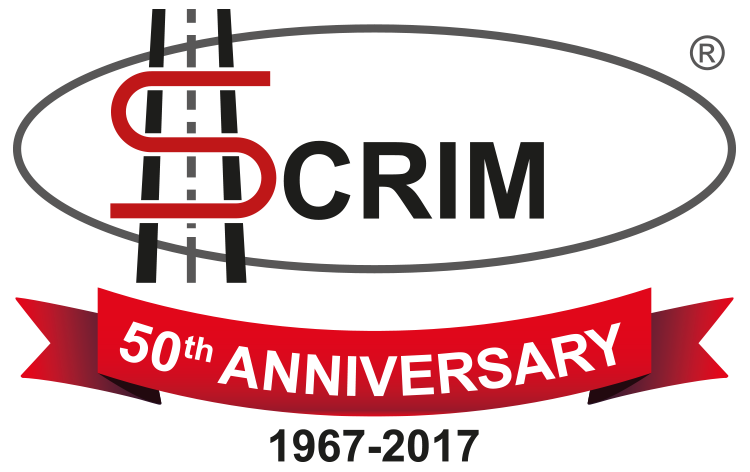SCRIM® celebrates 50th anniversary
January 2017
To celebrate the 50th anniversary of the SCRIM® road survey vehicle, we shared a SCRIM® fact each week during 2017.
Fact #1: W.D.M. Limited celebrate the 50th anniversary of SCRIM in 2017 – it was the machine that resulted in the company first becoming involved in the highway asset management sector.
Fact #2: SCRIM is the WDM® brand for investigation machines using the Sideway-force principle.
Fact #3: The first SCRIM® was built in 1967 for TRRL (Transport Road Research Laboratory) in the UK.
Fact #4: SCRIM measures the wet road skid resistance to ensure the surface meets regulatory levels and is safe for vehicles to use.
Fact #5: SCRIM measures the microtexture (roughness) of the surface chippings by lowering a freely rotating wheel on to the road at an angle of 20% to the direction of travel, under a fixed load. A jet of water is sprayed on to the surface immediately in front of the wheel, which is in continuous contact with the road. The force exerted on the wheel is measured by a load cell.
Fact #6: The SCRIM measurement tire is slick – it has no tread to influence the skid resistance of the road surface and is specially made for WDM® to fine tolerances to ensure consistency.
Fact #7: SCRIM operates around the world and there are machines in 18 countries.
Fact #8: WDM® has built more than 80 SCRIMs over the last five decades.
Fact #9: Measurement wheels are normally mounted on the nearside of the vehicle, but some have measurement wheels on both sides, particularly those manufactured for international clients.
Fact #10: WDM® operates a fleet of SCRIMs in the UK, surveying the highway network and main trunk roads.
Fact #11: The water tank on a SCRIM ranges from 420 gallons to 26,40 gallons.
Fact #12: SCRIM uses an inertial GPS system to ensure total accuracy of its data.
Fact #13: SCRIM has dynamic vertical load measurement of the test wheel.
Fact #14: The dynamic water flow control means SCRIM promotes economic water use by reducing flow at slower speeds, whilst maintaining water film thickness during surveys.
Fact #15: WDM® is the sole licensed manufacturer worldwide of SCRIM®, which is manufactured under license to the UK Transport Research Laboratory (TRL) in full compliance with the current British Standards BS 7941-1:2006.
Fact #16: WDM® founder Leslie Gardiner worked with the Road Research Laboratory to develop SCRIM after he was asked by the Ministry of Transport to adapt a lorry to test the safety of road surfaces.
Fact #17: The WDM® SCRIM is a completely self-contained system consisting of a vehicle chassis fitted with a large water tank, one or two measuring wheel assemblies and data recording electronics.
Fact #18: SCRIM is also fitted with a forward-facing video to record the survey route, capturing one frame every 16.4 feet, each of which is logged with its GPS location.
Fact #19: If the longitudinal profile option is selected, SCRIM can calculate and record longitudinal roughness, expressed as IRI and Variance (approx. 1, 33 and 98 feet wavelengths) simultaneously.
Fact #20: The introduction of regular SCRIM surveys, together with a skid policy based on the current standards, offers a cost effective option for local authorities to achieve and maintain reductions in their road casualty rates.
Fact #21: The SCRIM has a daily survey capacity of 125 to 185 miles, depending on road type.
Fact #22: A SCRIM® survey in the UK can be undertaken at two different target test speeds of 30 and 50 mph. The permitted speed range covering these target speeds is 15 to 50 mph. Skidding resistance data recorded at speeds within this range can be speed corrected to give equivalent values at 30 mph.
Fact #23: Skid resistance data is recorded continuously by the SCRIM® and stored at 3.9 inch intervals. The operator controls the survey and adds location markers to the data stream during the SCRIM® survey. Post processing can calculate averages over longer section lengths of 3.3, 8.2, 16.4, 32.8 and 65.6 feet.
Fact #24: Skid resistance of road surfaces is one of the primary factors that determine the safety of roads and the wet skid injury crash rate on road sections with “low” skid resistance is 4.5 to 9 times greater than that for all roads. Results of crash site analysis indicated that a 0.1 increase in skid resistance (measured in terms of Mean Summer SCRIM® Coefficient, MSSC) causes a reduction in injury crashes of 30% on wet roads & 20% on dry roads.
Fact #25: There are currently 17 SCRIMs operating in the UK, and more than 30 SCRIMs operating abroad covering Italy, Spain, Belgium, France, Portugal, Slovenia, New Zealand, Australia, Canada, China, Argentina and Chile.
Fact #26: In New Zealand, where SCRIM® has been used with a skid policy, wet road accident rates have been reduced by nearly 40%.
Fact #27: SCRIM® has been operating in New Zealand for two decades, providing a full network survey. New Zealand Transport Agency say that in addition to helping reduce skid related fatalities on their roads, WDM® has delivered a cost/benefit ratio of 35 to one.
Fact #28: WDM® survey the entire New Zealand network annually – a length of 14,000 lane miles – and over the past 20 years have streamlined the operation to deliver greater efficiencies, incorporating greater levels of technology. As well as producing SCRIM® Coefficients or validated equivalent, in both wheel paths, the survey also measures both the air and road surface temperature; MPD texture, rut depth and IRI roughness in both wheel paths; and the gradient, crossfall and horizontal radius of curvature.
Fact #29: In addition to responding to found defects, New Zealand Transport Agency uses SCRIM® data to monitor highway performance; plan future work programs; analyze trends; and predict how road conditions might change in the future. Information is stored in the agency’s RAMM database and used for many aspects of network modelling.
Fact #30: SCRIM® surveying is very accurate. The trucks based in New Zealand return to the UK each year for a complete service of the technical equipment and every nut and bolt on the vehicles.
Fact #31: While the SCRIM® in New Zealand is on the move, a transverse bar with 20 lasers defines the transverse profile over a road width of 10.8 feet. The rut depth in each wheel path is calculated from this transverse profile using a simulated 6.4 feet straight edge. The data is used to determine the average, maximum and minimum rut depth and the standard deviation and the distribution of rut depths every 65 feet.
Fact #32: Collected SCRIM® data goes through multiple validation checks for accuracy. John Donbavand, National Pavements manager at New Zealand Transport Agency, calls it “the largest validation programme in the world”, with the machines put through rigid ‘repeatability’ tests using comparative data.
Fact #33: When SCRIM® first began surveying the road network in New Zealand in the 1990s it had to be followed by a separate bowser to ensure it had enough water because of a shortage of fill up points along the routes.
Fact #34: One of the great advantages of SCRIM® over alternative methods of measuring highway friction is its ability to measure on horizontal curves (corners), which is often a critical location and a ‘hotspot’ for crashes.
Fact #35: The SCRIM® measures the dynamic vertical load, which is critical. The vertical load can peak to two or three times the static load. This occurs due to sudden changes in the road surface and systems that ‘assume’ contact loads are inaccurate, especially over shorter sections lengths <164 feet.
Fact #36: SCRIMTEX is a development of the SCRIM® and supplements the wet road skidding resistance by measuring, simultaneously, the surface macro-texture in front of the test wheel. This can be achieved in both wheel tracks of a double sided SCRIM® device and provides, in conjunction with air and surface temperature, the ultimate requirement for assessment of road surface condition monitoring for network surveys.
Fact #37: Longitudinal profile (roughness) is measured by SCRIM® using two lasers, one in each wheel path, together with accelerometers to remove vehicle movement, and deducted from the laser output to provide a road profile. The International Roughness Indicator (IRI) is calculated from the longitudinal profile using the World Bank Quaeter Car model and reported every 65 feet.
Fact #38: On SCRIM® road texture is measured by three 62.5 kilohertz lasers, one each in the left and right wheel paths and one between the wheel-paths.
Fact #39: The option of macrotexture measurement on SCRIM® allows the recording of raw texture profile on 0.04 inch intervals. This can be used to measure crack depths on transverse cracks.
Fact #40: Survey equipment features a geometry measurement system using three axis accelerometers and gyroscopes to sense the vehicle attitude as the SCRIM® travels along the road. Inclinometers measure the forward or back tilt of the vehicle for gradient and the side-to-side tilt of the axles for cross-fall.
Fact #41: Gyroscopes and accelerometers are used to sense the movement of the SCRIM® around corners to calculate the horizontal and vertical curvature. Geometry data is reported at every 33 feet.
Fact #42: GPS equipment is fitted to SCRIM® to sample the Omni-Star satellite to record the differential GPS coordinates of the center-line. Tilt sensors for cross fall and gradient, together with a gyroscope, provide alignment details when out of sight of the satellite. Information is post processed using LINZ base stations.
Fact #43: Researchers at Virginia Tech Transportation Institute (VTTI) in America are currently evaluating the safety of highway surfaces in several US states using the Sideway-force Coefficient Routine Investigation Machine (SCRIM®), from W.D.M. Limited in Bristol. The project, funded by the Federal Highways Administration, analyzes continuous stretches of pavement to determine whether improving highway materials or design reduces crashes and save lives.
Fact #44: The data collection phase of the Virginia Tech Transportation Institute (VTTI) evaluation of the safety of US highway surfaces, started in Washington D.C. and will include testing in Florida, Indiana and Texas. More than 32,000 people die annually on America’s roads, more than half in off-road or skid related accidents.
Fact #45: When WDM® manufactured a SCRIM® for US market it was constructed around an American-built truck chassis to comply with emission regulations.
Fact #46: The latest SCRIM® manufactured by WDM® was built for one of Italy’s largest road survey companies. It was the second road survey vehicle made for Sineco Spa in Milan, who are responsible for managing 930 miles of the Italian national motorway network.
Fact #47: More than 350 of the slick measuring tires are used every year by WDM® during SCRIM® surveys in the UK and New Zealand.
Fact #48: WDM® developed the mini-SCRIM® in the 1990s for surveying narrower roads and for use in towns and cities.
Fact #49: The mini-SCRIM® measured the friction of London’s cycle lanes and the routes used for the 2012 Olympics cycling events.
Fact #50: All WDM® SCRIM® vehicles undergo annual independent testing by TRL before being awarded an accreditation certificate to confirm reliability and reproducibility of data gathering.
Fact #51: Viewing software for SCRIM® allows easy identification of poor sections of road. Locational information precisely locates the position and can interact with Google Earth.
Fact #52: In 1990 WDM® was the first to have traffic management employed when SCRIM® measured surface friction of roads in Singapore. Police outriders stopped traffic at junctions to allow the survey to continue without interruption.

Share this





